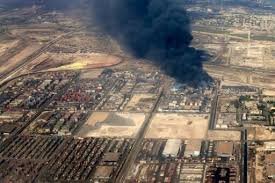
A catastrophic explosion at Iran’s Shahid Rajaee Port, located near the strategic Strait of Hormuz, has led to a fierce fire that continues to rage two days later. The blast, which took place on Saturday, has claimed the lives of at least 46 people and left over 1,000 injured. Although most of the injured have been treated and released, 138 people are still in the hospital, some with serious injuries.
The explosion occurred at one of the country’s largest commercial ports, causing widespread damage. Iranian state TV has reported that firefighters are still battling flames at the site, with heavy smoke continuing to rise above the area. While the fire continues, authorities are waiting until it is fully under control before assessing the full extent of the damage.
The Explosion and Aftermath
Witnesses and security camera footage on social media revealed the terrifying moments before the explosion. What started as a small fire with orange-brown smoke quickly escalated into a massive fireball. CCTV images show men walking near the area and a forklift truck passing by shortly before the devastating explosion occurred, sending a fireball into the sky.
The blast struck the hazardous materials storage depot at the port, where flammable chemicals and materials were reportedly being kept. This is suspected to have been the source of the explosion, although officials have yet to determine the exact cause. Iranian authorities are also probing the incident to determine if there was any negligence or intent behind the blast.
Authorities React
In the aftermath of the explosion, Iranian officials have declared a national day of mourning. In Hormozgan province, where the port is located, three days of mourning have been declared. President Masoud Pezeshkian visited hospitals in the nearby city of Bandar Abbas on Sunday to meet with those injured in the blast.
Meanwhile, the Iranian government has taken measures to prevent further casualties, urging residents to stay indoors and wear protective masks due to lingering smoke. The authorities have also closed schools and offices in the area for safety.
Speculation on Military Links
While Iranian authorities have denied that the explosion was linked to military activities, there has been speculation that the blast may have involved chemicals related to missile production. The New York Times quoted sources with ties to Iran’s Islamic Revolutionary Guard Corps (IRGC) suggesting that sodium perchlorate, a key ingredient in solid fuel for missiles, might have been involved in the blast.
However, Iranian officials, including Defence Ministry spokesman Reza Talaei-Nik, denied these claims, stating that no military-related cargo was present at the port at the time of the explosion. Despite this, the blast comes amid a backdrop of years of tensions between Iran and Israel, with Israel having previously conducted cyberattacks targeting Iranian infrastructure, including the Shahid Rajaee Port in 2020.
International Assistance and Ongoing Efforts
To aid in the ongoing firefighting efforts, Russia has dispatched specialists to assist Iranian emergency responders. The situation remains critical, with authorities focused on bringing the fires under control before a comprehensive investigation into the cause of the blast can begin.
The explosion and its aftermath have cast a shadow over ongoing negotiations between Iran and the United States on Tehran’s nuclear program. Although the two sides are meeting in Oman for high-level talks, the explosion at the port has added a new layer of complexity to the already tense situation in the region.
Conclusion
As investigations continue, the Iranian government is facing pressure to explain the cause of the explosion and address the potential military implications. With fires still burning at the Shahid Rajaee Port, the scale of the damage remains unclear, but the impact on both the local population and the nation’s infrastructure is undeniable.
Sources By Agencies


